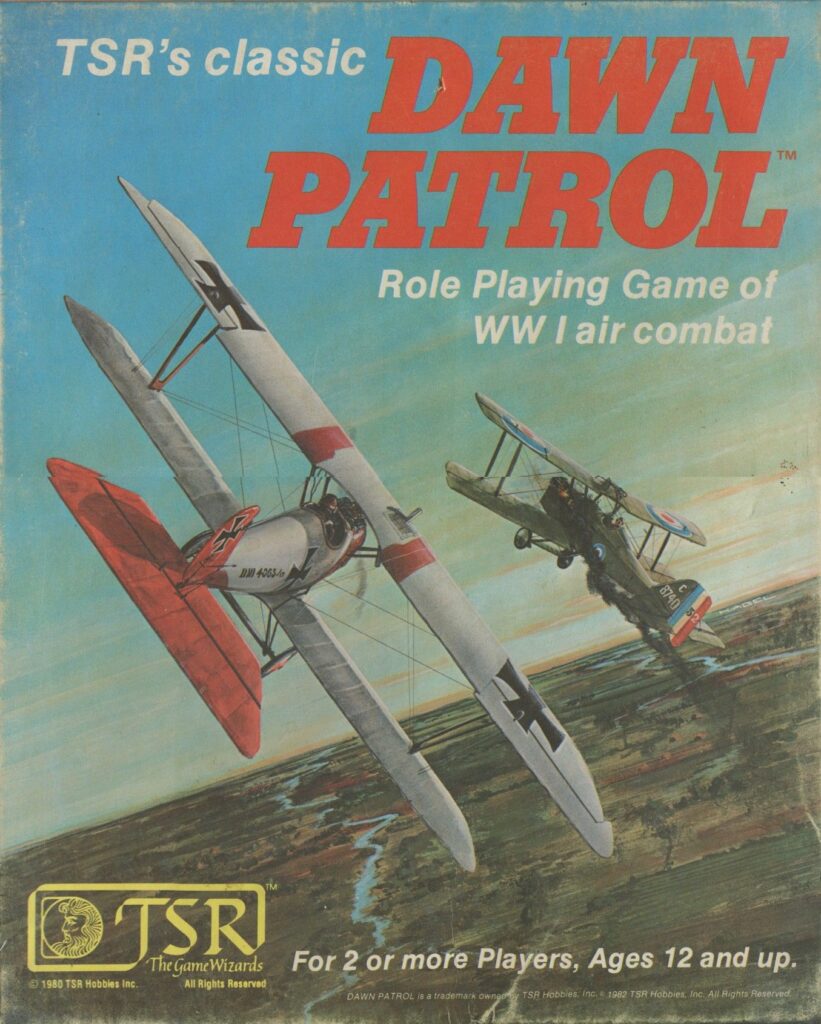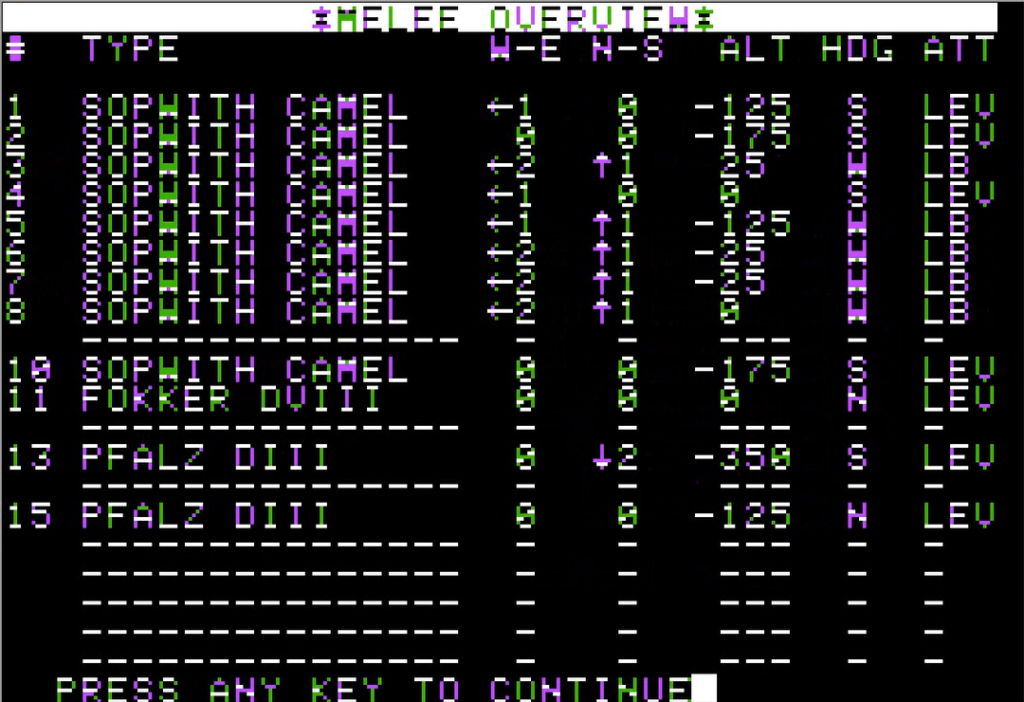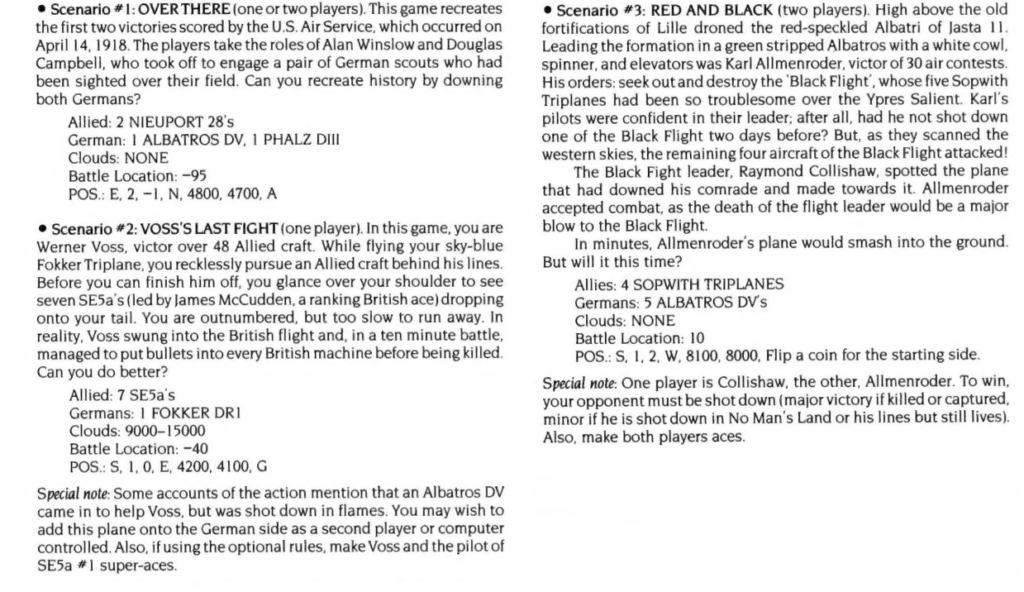
Eagles by Robert Raymond, published by SSI, USA
First release : September 1983 on Atari 8-bits and Apple II
Tested on : Apple II, Atari 8-bits and Commodore 64 emulators
Total time tested : Around 4 hours
AAR : Early 1917, Late 1917, Early 1918, Late 1918
Average duration of a battle : 15 minutes maximum
Complexity: Low (1/5)
Would recommend to a modern player : No
Would recommend to a designer : No
Final Rating: Well-designed but obsolete
Ranking at the time of review : 13/87
Summary :
Eagles is a casual but well-thought WWI tactical air combat game with significant customisation options and probably the second “campaign-mode” ever found in a wargame. Adequate in all categories but strong in none, somewhat repetitive, it received mixed reviews and average sales.
As usual, this review assumes you have read at least part of the AAR.
Air combat has long been a captivating subject for tabletop wargames, as it represents a facet of warfare where individual prowess endured in the era of industrial warfare. Among various air combat themes, World War I holds a special place in the hearts of wargamers. This bygone period, where chivalric values persisted and smaller-scale combat prevailed, allowed exceptional pilots, « aces », to win even when odds were stacked against them. Occasionally, those flying legends would engage in combat above the war-torn trenches of France and Belgium, and those duels are still remembered today. This is why I believe almost all of my readers can name more aces from WWI than from WWII.
Simulating air combat poses challenges due to the three-dimensional nature of the battles. On BoardGameGeek, I count roughly 10 to 15 WWI air combat wargames in 1983 and before. Some, like Sopwith (1977) and Blue Max (1983), simplify gameplay by excluding altitude, while others pile on the complexity.
It’s no surprise then that tactical air combat was quickly adapted on computers, beginning with Computer Air Combat (1980 – WWII only). However, many players likely discovered that having a computer manage complex altitude calculations didn’t necessarily make the game more enjoyable. This is where Eagles swoops in, fulfilling a niche in both theme (WWI) and complexity (casual) for gamers seeking a more accessible experience.
Alas, there is very little I can say about designer Robert Raymond. The design seems original, though it may have borrowed its scale and player progression from TSR’s extremely popular Dawn Patrol (1982)

Eagles was developed for Atari and then ported on Apple (both versions were in the same box in September 1983) and then on Commodore 64 (released November 1983). In 1986, SSI released a C64+Apple II box, but I don’t think the game was any different. The game was sold for $39.95 and the box included the disk, the manual and a reference card. The manual includes a short and well-written historical essay (“Angels with canvas wings“) by Joel Billings’s father : Robert S. Billings.
I played on emulators for the three platforms, and the only difference I noticed between is that the Atari end battle screen doesn’t include the amount of “bullet holes” in each plane nor how much ammunition was left.
A. Immersion
Poor. The game does not feel realistic – granted it does not try to be – and due to “plane stacking” you will spend more time on the overview screen than on the top-view screen. Eagles is salvaged by the number of horrible fates that can befall the pilots and their planes at the end of each battle.
B. UI , Clarity of rules and outcomes
Adequate. Eagles succeeds at making air combat simple, though again the top-view screen is near useless as planes are all stacked on top of one another, it does not indicate altitude and only shows planes within 2 “tiles” from where you are.

The UI starts to show its limitations when you control more than one plane: there is no way to check the damage received by your planes, or whether your gun is jammed or not so you need to remember what happens to your planes.
C. Systems
Adequate. Eagles must be judged as what it is : a casual dice-driven beer-and-pretzel game with an air combat theme. Apart from the latter, it shares little with Computer Air Combat, which was a deterministic simulation. Let’s compare doing a half-loop in the two games :
In Computer Air Combat you must :
- Make sure you have enough speed,
- Bank the plane so it is level / parallel to the ground,
- Point the nose up,
- Keep pointing it up for some time,
- When the half loop is complete, bank again so the plane is not inverted,
In Eagles, you must :
- Type the “half-loop” command and check the result of a (hidden) dice roll,
Eagles is indeed about dice roll. The game only has a limited number of available actions, some automatically successful (like slowly flying straight, slowly turning or gaining/losing altitude), others simply requiring a roll of “speed”, “maneuver” or both below the plane stats. Failing a dice roll forces you into the equivalent successful movement (a failed turn becomes a slow turn, a failed fast move or slip becomes a slow straight move). Altitude changes give +/- 5% to speed or turn rolls by 25 feet altitude step, a nice design-for-effect feature that makes getting an altitude advantage useful.
I feel the game is weakened by an action called “maneuver” (different from the plane stat), which automatically succeeds and randomly moves the plane in any direction and gives it a new facing. It feels like a trivial get-out-of-pursuit-card that the game did not need, and it weakens the tactical aspect ; there is no need to be supported by wingmen and no point in trying to stay in the back of a plane when there is a “teleport away” option.
Finally, the game tracks where the battle happens compared to the frontline, but it has no impact on the game except to check where the planes crashed. There is no ground target, no AA and no impromptu reinforcements. There is no sun either, whose blinding effect was so important in WWI warfare. Adding these would have made the game a lot more interesting.
D. Scenario design & balancing
Adequate. The game has a plane designer and a scenario designer, with the option to have some planes controlled by aces and even “super-aces”. If you don’t have ideas, the manual proposes three scenarios:

Eagles is one of the first wargames with a campaign mode of any sort (the only earlier wargame with a campaign mode I can think of is Galactic Gladiators), and while the impact of one mission on another is small (your performance only determines which plane you control), it certainly beats the one-off missions you had to design yourself in Computer Air Combat. Unfortunately and except for the balloon attacks, scenarios are always set piece dogfights : no unexpected reinforcement, no weather effect except cloud at a certain altitude, no ground attack missions and no scramble missions.
My main complaint regarding Eagles is the AI. Computer-controlled pilots have no preservation instinct at all, they don’t check whether a tile can be attacked before deciding where to move, and sometimes turn away from combat for no reason at all. They don’t even try to climb when fighting at the minimum possible altitude (25 feet, at this altitude there is a chance to crash every turn). Even worse, they don’t know how to unjam a gun and will immediately return to their airport in the (frequent) case where their guns stop working.
E. Did I make interesting decisions ?
A few of them every battle, all of them of course tactical.
F. Final rating
Well designed, but obsolete. Eagles is certainly not a great game and it has nothing special going for it. But 40 years later, it also has nothing really going strongly against it either except its AI : if you can stomach 1983 graphics you can still easily pick it up, play a short session (a battle with only one human pilot takes 15 minutes at most) and have a good time. There are better games covered on my blog, but none are as easy to jump into for a short relaxed session as Eagles.
Contemporary Reviews
Eagles reviews were all over the place. Computer Gaming World quite simply ignored it at its release – which I attribute to its secret rule “if you don’t have something nice to say about a game (especially SSI’s) don’t say anything at all“. They only covered it… in 1993 as part of Evan Brooks’ review of all computer wargames”. He shared my point of view by calling the game “enjoyable, albeit unrealistic”. I disagree with Brooks’ statement that the game feels more like chess than a simulation : I don’t throw dice every turn when playing chess.
Edward Bever writing in Analog Computing dissed the game in January 1984, allocating two paragraphs to explain how slow Eagles is, before complaining about the cumbersome UI and the lack of realism. The conclusion is scathing : “Eagles is authentic without being particularly realistic; it is simple without being especially playable. I find it mildly enjoyable as a sort of three-dimensional chess, but no one else whom I have asked to try it has reacted at all favorably to it. SSI has brought us many fine war games, but Eagles does not rank among them.“
It seems Bever did not include Dave Albert from Softtalk among his friends. The latter states in November 1983 : “Eagles is a wonderful game and a very good introduction to war games for the novice”, a review echoed by Neil Shapiro writing for Electronic Games (September 1984). Forrest Johnson writing for Softline (November 1983) takes an intermediate position : there is some strategy to this game, but it is simple enough so that even a novice can become an ace. And even a veteran will occasionally be left to cry“.
The game sold 7 400 copies in the USA, 3 900 for the Apple II / Atari box, 3 300 for the Commodore 64 version and less than 200 for the 1986 Apple / Commodore 64 rerelease.
2 Comments
> There are better games covered on my blog, but none are as easy to jump into for a short relaxed session as Eagles.
I enjoyed this series of AARs a lot, so I’d say the sentence also holds for short relaxed _blog reading_ sessions.
The game made for excellent blog reading, I agree.
Tabletop air games are difficult to sell. As in everything, I’ve discovered that complexity is very difficult to sell to an audience (even more to a tabletop audience) so Eagles gets my approval for selling the…. “verisimilitude” of air combat instead of the painful details.
Tho, “This is why I believe almost all of my readers can name more aces from WWI than from WWII.” places me into a very uncomfortable position!